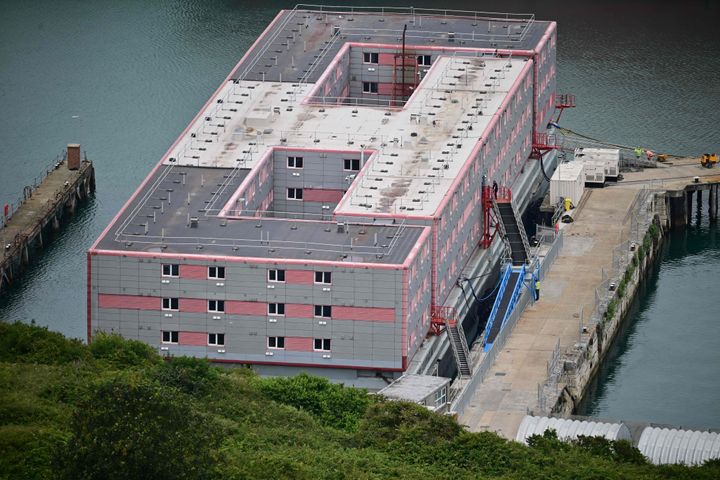
The discovery of a bacteria in the water supply of Bibby Stockholm led to the rapid evacuation of all migrants on board last week – and it has raised serious questions about how this situation even arose in the first place.
The migrant barge, meant to be a major deterrent in the government’s multi-pronged plan to reduce small boat crossings in the English Channel, has only generated negative headlines for the Conservatives so far.
And just four days after the first 39 men boarded the barge, they were evacuated as Legionella was found on the boat – posing a threat to everyone on board, including staff and contractors.
If water infected with Legionella is inhaled, it can trigger Legionnaire’s disease, which has a mortality rate of 10 to 80%, depending on the health of the individual.
The Home Office has said none of those on board show symptoms of Legionnaries’ disease.
But, there’s still a lack of clarity around what actually happened, and what the government plans to do about it.
Here’s just six questions ministers need to answer after the crisis.
1. What checks were carried out in the first place?
Worries around the conditions of the barge have been circulating ever since the idea of using temporary accommodation first became a reality.
And, as soon as Bibby Stockholm arrived, some called it “a floating Grenfell” because of the fire safety concerns.
Ministers repeatedly claimed that asylum seekers would only be moved onto the barge if conditions were safe and legal – so it’s not clear how this health scare emerged.
Did the government follow its own guidelines around re-commissioning heating and ventilation systems on board?
Did the water system have a sanitation check before people got on?
The bacteria is usually found in old heating systems which have not been used for months.
2. Were people moved on board before the results of the test came back? And if so, why?
Apparently the legionella testing took place on July 25, and migrants were moved on board on Monday, August 7.
This was the start of the “small boats week” – meant to show PM Rishi Sunak takes reducing the supposedly illegal crossings of the English Channel seriously – the first migrants arrived on the barge in the afternoon.
According to the local council, the legionella test results were revealed on that Monday. It’s not clear how many people knew about it at the time, or if that was before or after the migrants started boarding the barge.
3. Why was there a breakdown in communication?
The local Dorset council, contractors on the barge and the Home Office all revealed a slightly different series of events about who knew about the bacteria.
The council said Home Office contractors were told about the results on Monday – although migrants were not removed until Friday.
It also said a Home Office staff member was told about the bacteria on Tuesday.
A government source told Sky News there was no record of this conversation. It said the Home Office had a written notification about the bacteria on Wednesday evening.
A Home Office spokesperson said: “The health and welfare of asylum seekers remains of the utmost priority.
“The Home Office and our contractors are following all protocol and advice from Dorset Council’s Environmental Health team, UK Health Security Agency and Dorset NHS who we are working closely with.”
There’s also a question mark as to why the health department was not more involved, as BBC Breakfast host Sally Nugent pointed out to the health secretary Steve Barclay on Monday.
And, according to the Care4Calais charity, those on board received delayed comms about what was happening on the barge and “were unable to find staff to supply information” even after authorities found out about the bacteria.
The charity also asked “why people were kept on the barge, and why more transfers were attempted, when the presence of the bacteria was known”.
4. When will migrants be moved back onto the barge?
Barclay claimed on Monday that he wants migrants to return to Bibby Stockholm – but he has not said when this might be.
No.10 has also refused to offer a solid date, saying only that it wants people to be back on the boat “as soon as possible’.
5. What changes will be made before people return?
Legionella is hard to eliminate once it gets into a water system.
Bibby Stockholm, built in 1972, may need a whole new system to fully remove the bacteria – and that would be yet another setback for the government’s plan to reduce asylum seeker numbers.
6. What happens if migrant refuse to board the barge?
This health scare could make asylum seekers even more reluctant to board the barge.
One anonymous migrant told Sky News that they felt like “we are being treated like less than animals” on Bibby Stockholm after the bacteria discovery.
Sky News also had access to a Home Office letter which claimed “accommodation is offered on a no-choice basis” to asylum seekers.
The letter, allegedly sent to someone who was refusing to board the barge, raises questions about what happens to those who decline the government’s accommodation – will they become homeless?
There are also worries about how appropriate the barge is for those who disabilities, mental and physical health problems, along with those fleeing torture and persecution
Care4Calais chief executive Steve Smith said that around 20 asylum seekers did not board Bibby Stockholm last week due to legal challenges.
Following the legionella discovery, he added: “We have always known our concerns over the health and safety of the barge are justified, and this latest mismanagement proves our point.”
